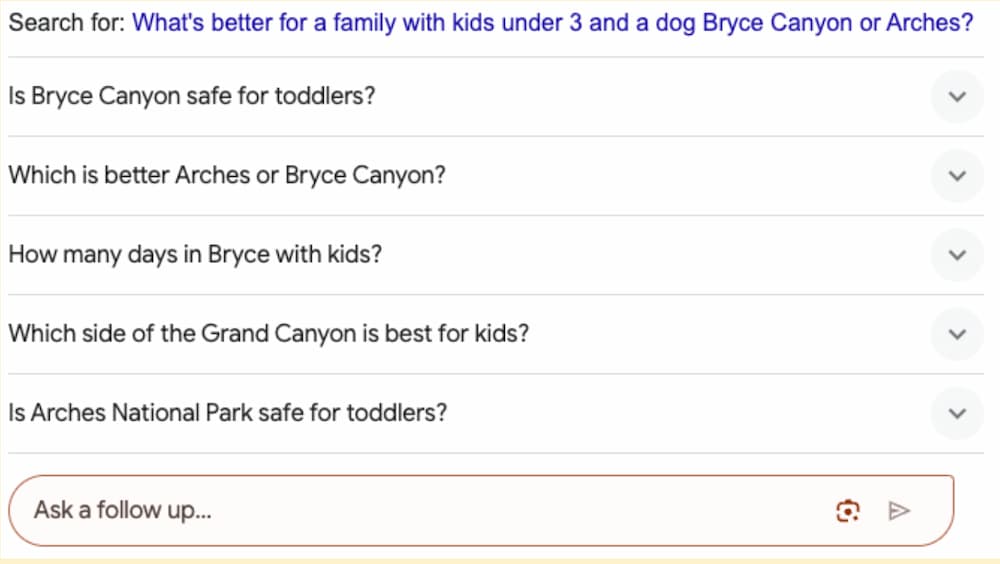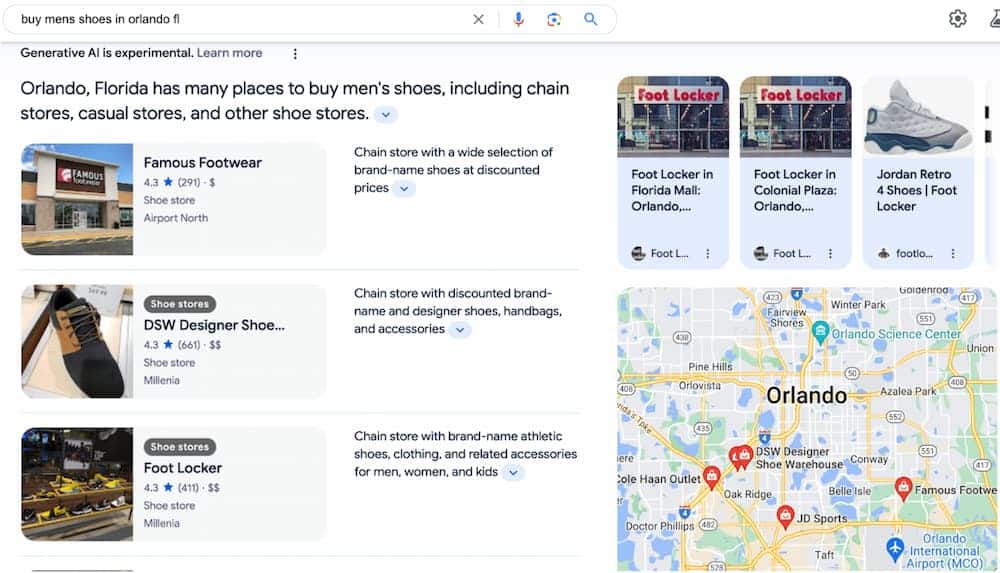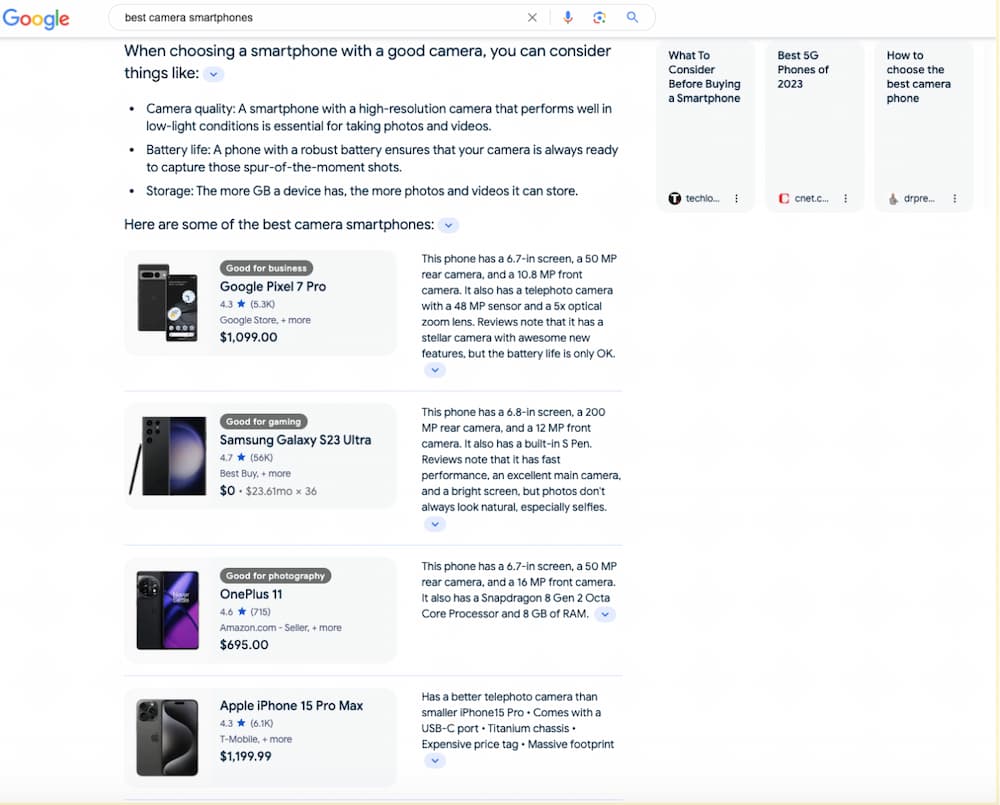What is Google's Search Generative Experience (SGE)
Search users are used to, and frustrated by, having to dissect their queries into smaller, manageable fragments, sift through mountains of information, and painstakingly piece together to get the comprehensive answers they want. Google is looking to simplify how users search for and find information.
Google is introducing its Search Generative Experience (SGE) to its search functions to help users access accurate and in-depth information faster. It’s intended to reduce search time and enhance the overall online experience. For website owners, embracing SGE’s model of search means staying ahead of the curve.
Websites optimized for SGE will rank higher and offer more value to their visitors. Your content will align with Google’s vision of comprehensive, user-friendly search results, ensuring that your website becomes a go-to destination for information-hungry users. In this article, we will explain how SGE works, how it’s predicted to impact SERPs, and how the growing use of AI influences search.
What is Generative AI in Google Search?
Unlike traditional search algorithms that rely on predefined rules, SGE utilizes AI to understand user queries and generate contextually relevant search results. When a user submits a query, they can use SGE’s AI models to understand the user’s intent better. This analysis extends beyond surface-level keywords, considering the context in which the query is made.

From your original search, it will offer additional search options (similar to “People also ask”) and provide direct answers for these queries in the form of snippets. While a user can click the link to the webpage for this information, they can continue to generate answers on the SERP from the queries listed.
When explaining how SGE works, Google uses the example of planning a dream vacation with your family: kids under 3 years old and a beloved furry friend, your dog, in tow. You’re torn between two national parks, Bryce Canyon and Arches, and you’re eager to make the right choice for an unforgettable experience.
Instead of navigating a maze of web pages and piecing together the information from multiple sources, SGE presents a user-friendly snapshot of key information for your family vacation dilemma. After the initial query about the two parks, you might wonder, “How long should we spend at Bryce Canyon with young kids?”

With a simple click, you enter a conversational mode (similar to a chatbot) where you can explore your travel plans.
What is the main goal of generative AI?
The main goal is to simplify the search experience and reduce the bounce rate from Google search to websites listed on the SERP. SGE uses natural language processing (NLP) AI to comprehend the nuances of language. This AI is designed to resemble how a human collects information.
We ask more than one question when looking for answers and apply this question against varying reasons. “I’m looking for [ product/service ] for this specific [reason/application].” As search currently works, you can jump down a rabbit hole of related questions and information. Often, you run into a lot of articles that hint that they cover the topic you’re searching for but then fall short and you have to begin your search all over again.
SGE uses NLP to maintain your context as you navigate through your inquiries.
Google’s shift to generative AI is about making search an easy, quick and intuitive process. It uses the answer-engine format to provide snippets on the SERP for user queries. Organizing the content on your website for answer engines (and ultimately SGE) is about improving your search engine ranking.
Addressing Complex User Queries
SGE takes a deeper look at the context of the initial question and suggests follow-up questions (think of “People also ask”). When your content addresses complex user questions in your content, your website becomes the go-to source for detailed answers.
Craft your articles, guides, or FAQs to be informative, meticulously detailed, and offer in-depth insights into your products or services. Well-structured content that identifies complex questions and provides direct answers is key to improving your SEO. Think about the questions your customers and clients ask you directly or through reviews. Are the answers simple or do they require a longer explanation? If the answer is longer than one or two sentences, turn the question into a header and write a paragraph that can be used as a featured snippet for SGE to use on the SERP.
Organizing Information Effectively
When Google’s SGE evaluates your content, it doesn’t just look for information – it looks for clarity and organization. By presenting your content in a structured manner, you’re signaling to SGE that your content is informative, user-friendly, and easy to comprehend. Consequently, your content is recognized as a reliable source of information, increasing the chances of being presented to users seeking answers in your industry.
Think of it as creating a roadmap for your readers to navigate easily. Incorporate headings, subheadings, bullet points, and other formatting techniques that break down complex information into digestible chunks.
Enhancing User Experience
Think about what you’d love as a user when using search or visiting a website and implement these changes on your own site. For example, nobody likes a slow-loading site. So optimize for speed. Do websites you visit on your computer read the same when you’re looking at it on your phone? Are they simple to navigate? Ensure your site is mobile-friendly and easy to navigate on any device. Remember to sprinkle in eye-catching visuals (like infographics) or engaging videos to explain your products or services. Interactive elements keep visitors hooked.
Content Diversity and Authority
SGE appreciates websites with outside perspectives about your brand, products, and services. Responding to comments and reviews from your customers adds to your trustworthiness. You can use these comments and reviews to produce diverse content on your site. The more perspectives you write from will reach a wide range of existing and potential customers looking for your products and services.
For instance, if you run a website dedicated to fitness and nutrition, don’t limit your content to just workout routines and dietary tips. Think about incorporating mental health and mindfulness articles, healthy recipes, user success stories, and expert interviews.
Content is not limited to written content. You can diversify your content by including videos, infographics, and other multimedia elements throughout your site. By offering a varied approach to well-being, you cater to a broader audience and establish your website as an authoritative resource. This approach gains favor with Google’s EAT guidelines, SGE, and ultimately improves your SEO ranking.
SGE’s Predicted Impact on Your SEO
SGE will work hand-in-hand with Google’s growing use as an answer engine. It hopes the impact of SGE will improve website’s SEO and Answer-Engine Optimization (AEO) tactics.
AEO involves structuring content to provide direct, zero-click answers to user queries. These zero-click answers are shown as snippets beneath the questions in Google’s search bar. Websites that provide well-structured, informative and concise answers are more likely to be featured prominently by SGE.
Streamlining Information Retrieval
SGE relies on answer engine content formatting and advanced NLP to understand the intricacies of user queries (including context, intent, and nuances). By providing direct and related answers on the SERP, users don’t have to click on multiple links, read large blocks of text, and jump back to the search queue to write multiple variations of the same query.
For example, if a user asks, “What are the health benefits of green tea for weight loss?” The keywords, “health benefits,” “green tea,” and “weight loss” are used by SGE to provide a response. It recognizes that the user is looking for detailed information about the health advantages of green tea concerning weight loss. SGE retrieves information directly related to this query, suggests commonly asked follow-up questions, and suggests information that is relevant.

Simplifying Shopping Decisions
When you’re shopping for products online, you probably want the ability to compare these items side-by-side. Whether it be product information, where you can purchase these products (online or at a physical store), or even reviews from people who have already purchased the product, SGE provides this information and more. It understands that users want the details, upfront and easily understood.
SGE uses Google’s Shopping Graph to show real-time data about billions of products online. Users can compare similar items before clicking the link to the purchase page. Anticipating that users might want to explore additional details, it provides
- feedback and reviews from fellow shoppers,
- a rundown of the product’s advantages and disadvantages,
- specific details about its materials, available colors, and various sizes.
Beneath the available store locations or product listings, SGE suggests common follow-up questions (or you can ask your own). This proactive approach streamlines the shopping process, empowering consumers to make well-informed decisions. You can benefit from this by making sure your product listings are thorough, detailed, and up-to-date.

What is the difference between AI and generative AI?
To truly grasp the transformative power of Google’s Search Generative Experience (SGE), it’s essential to understand the fundamental shift it represents in search technology. Unlike traditional search algorithms, which rely heavily on keywords to match user queries with relevant web pages, SGE harnesses the capabilities of Generative AI, making it contextually driven and capable of understanding user queries with nuance and sophistication.
Traditional Search Algorithms
Traditional search algorithms have been the workhorses of the internet for years, primarily relying on a keyword-centric approach. When a user enters a query into a search engine, these algorithms analyze the query to identify specific keywords and phrases. These keywords are then matched against an index of web pages previously crawled and indexed by search engine bots.
The goal is to find web pages that contain these keywords and present them to the user.
This keyword-centric approach has its limitations. It can lead to results that rely heavily on the exact words used in the query, sometimes overlooking web pages with valuable information that might use synonyms or related terms.
Let’s say you’re looking for information about smartphones with a high-end camera. The first thing you’ll search for is probably, “best camera smartphones.” Traditional search algorithms focus on the keywords “best,” “camera,” and “smartphones.” Then it retrieves web pages that contain these specific terms (identified in their headers, meta descriptions, and reviews) and displays them as search results.
However, these results may reflect something other than the user’s true intent – finding a smartphone with a great camera. The algorithms often overlook web pages that discuss camera quality in detail but don’t use the phrase “best camera smartphones.”
Traditional algorithms need help understanding the context and intent behind user queries. While a keyword-centric approach has worked for many years, it has become inferior. Users expect more sophisticated and context-aware search experiences.
Generative AI in SGE
SGE’s Generative AI takes a context-driven approach to user queries. It identifies keywords and examines the query’s broader context, intent, and semantics with NLP processing. Generative AI delves into the context and semantics of the query.
Let’s use the same search from earlier, “best camera smartphones.” In this case, Generative AI recognizes from the wording order that you’re looking for smartphones known for their camera performance. It understands that “best” implies you’re looking for a customer-reviewed, high-quality item. “Camera smartphones” shows that you’re focused on the camera application for the smartphone unit. SGE provides search results that include smartphones with publicly recognized exceptional camera capabilities, even if they don’t use the exact phrase “best camera smartphones.”
This context-driven approach makes sure that you receive more relevant and comprehensive information. Generative AI’s contextual understanding presents results that include
- detailed reviews,
- comparisons,
- and user experiences related to camera performance in smartphones.

How do I enable generative AI in Google?

You can activate SGE for your personal Google searches through Google Labs. While SGE is accessible in many countries, it might not be active for all Google searches. Google has elaborated in their blog that they are extending Search Labs and SGE to over 120 new countries and regions worldwide, including Mexico, Brazil, South Korea, Indonesia, Nigeria, Kenya, and South Africa.
As part of this expansion, they are introducing SGE support for four additional languages: Spanish, Portuguese, Korean, and Indonesian. This means that if, for instance, you are a Spanish speaker in the U.S., you can now utilize generative AI in your preferred language for Search. Search Labs offers a way to experiment with early-stage features on Search and is available on the Google app (Android and iOS) and on Chrome desktop. Once enrolled in Search Labs, activate the SGE experiment to get started.
What is the downside of generative AI?
With the rise of AI-generated content, SGE and generative AI are victims of misleading or biased content. AI content distinctly lacks the human element and is pieced together from popular sources. These sources are not always factual or supported by data. This information can negatively impact your website’s reputation and user trust in your content.
To avoid this pitfall, make sure your content is factual, and supported by evidence or professional insight. You can use your FAQs as headers in your content for generative AI to easily locate.
Future-Proof Your Seo Efforts
Google’s Search Generative Experience is a shift in how users traditionally engage with online search. Its intent is to streamline the search process, offering faster access to accurate and comprehensive information, and significantly enhancing the online experience. By optimizing your content for SGE, you can enhance your website’s visibility and authority in search results.
Consider partnering with My Website Spot to make the most of SGE and future-proof your SEO efforts. With over 18 years of successfully navigating Google’s algorithm updates, we have the experience to help your website overcome ranking challenges during Search updates. Contact My Website Spot for SEO services and a tailored approach to utilize SGE for your website’s visibility, authority, and user experience.



